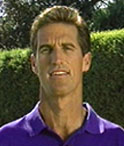Court Movement:
The Forehand
By Bob Hansen
The Initial Move : a push with the Inside Foot and a step with the Outside Foot toward the ball. |
Tennis is a game of movement, and great tennis moves great movement.
The ability to move effectively and efficiently on the court is as essential to playing your best tennis as are stroke mechanics.
To hit the ball as well as you are capable, you must be in position, and this means developing the movement skills to reach balls anywhere on the tennis court.
Without good movement, you may as well leave all those beautiful strokes on the practice court. Effective movement means the ability to move relatively quickly and arrive in position to hit the ball.
Focus on the smooth, effortless movement of the world's great players when you watch matches on television. By learning the same movement patterns yourself, you will take a big step toward reaching your real potential--beyond just working on your strokes.
 |
The Outside Foot is the right foot, closer to the ball, and the Inside Foot is the left. |
The Initial Move
Superior movement patterns for every shot in tennis begin with the first step or what I call the Initial Move.
Start in a good, balance ready position, with your feet spread a little more than shoulder width, the knees flexed, and the body upright.
The initial move begins with a push with the Inside Foot and, at the same time, a step with the Outside Foot toward the ball.
For a right handed player, the Outside Foot will be the right foot on a forehand, that is, the foot closer to the ball. The Inside Foot for a right-handed forehand, will be the left foot, the foot further from the ball.
Position to the ball with the Outside Foot. |
The Movement Pattern
Watch closely in the animations: I push with the Inside Foot and step with the Outside Foot toward the ball.
At the completion of the turn, the player is balanced and his weight is centered between his feet. From this position, he is ready to hit or, more importantly, he is ready to move.
The running style to the ball should be smooth relaxed, maintaining a balanced posture. This allows for effective sitting of the ball, proper hitting alignment and the ability to change directions quickly. As the player arrives, he gauges his distance and his position to the ball with the Outside Foot.
Positioning behind the ball allows you to hit open stance effectively. |
Open Stance Alignment
Watch how I align the outside foot behind the line of the flight of the ball. Now, I am in position to do two things.
I can step forward into the line of the shot with my left foot as I hit. But I can also hit effectively off the Outside Foot keeping the stance open.
This open stance alignment is critical in pro tennis, and something players at all levels should develop as well.
3 movement errors : Shuffling to the ball; too much weight to the outside; hitting with a crossover step. |
Common Movement Errors
Many players, however, have difficulty executing this balanced movement pattern. Do you recognize your forehand in any of
these movement errors?
The animation to the left shows the 3 most common movement errors. Watch the sequence through and notice them in this order. Shuffling before turning. Moving to the ball with the weight too much to the outside. Hitting off the Outside Foot with a crossover step to the ball.
Recovery
The movement pattern after the hit is called the recovery. Great movers are not only skilled at getting out to the ball in position. They are also skilled at quickly getting back into position to move to the next ball. We want the most efficient possible method with the fewest possible steps. Your goal is to return to the center of your opponent's possible angles and re-establish a good ready position before he hits.
Watch a close up of the exchange, followed by a wide view of the entire pattern and the movement back to the middle. |
The Recovery Exchange
This is accomplished by exchanging the position of the feet after the hit. Watch in the animation how I begin the recovery by exchanging the position of my feet. The outside foot comes back and replaces the inside foot. This is followed by shuffling or side-stepping back toward the middle.
The outside foot brushes the ground softly, and the player stays upright. This keeps you grounded and stops you from jumping, so your movement is smooth and rhythmic. If there is not enough time to recover all the way to the center, re-establish the ready position prior to the opponent's hit.
This is critical so that you can move with equal ease to reach a ball in either direction. With this pattern I have gone no further than is necessary to hit the ball and then in the very next step I have begun to recover and prepare for the next ball. There is no wasted motion. This allows me to stay ahead or gain ground in the point, or to catch up if I am behind.
Common recovery errors: running through; swinging the outside foot; recovering with the left foot. |
Recovery Errors
Now compare this pattern with some common recovery errors that are less balanced and efficient and waste precious steps. Watch the sequence to the left. The three most common errors are: running through the shot, swinging the outside foot around, and hitting and bringing the left foot back.
In the next article we'll look at patterns of great court movement on the backhand.




